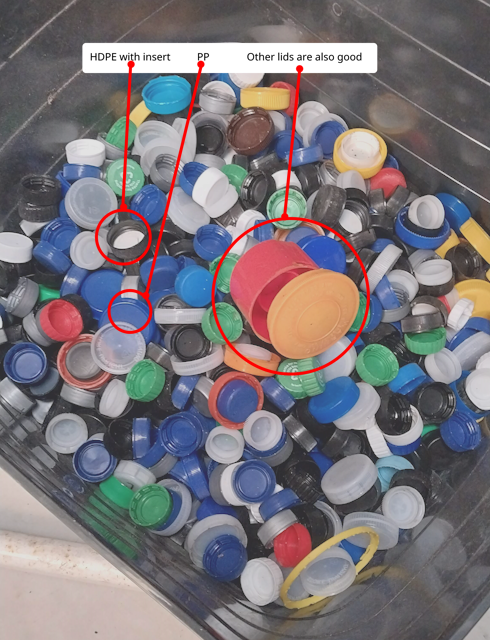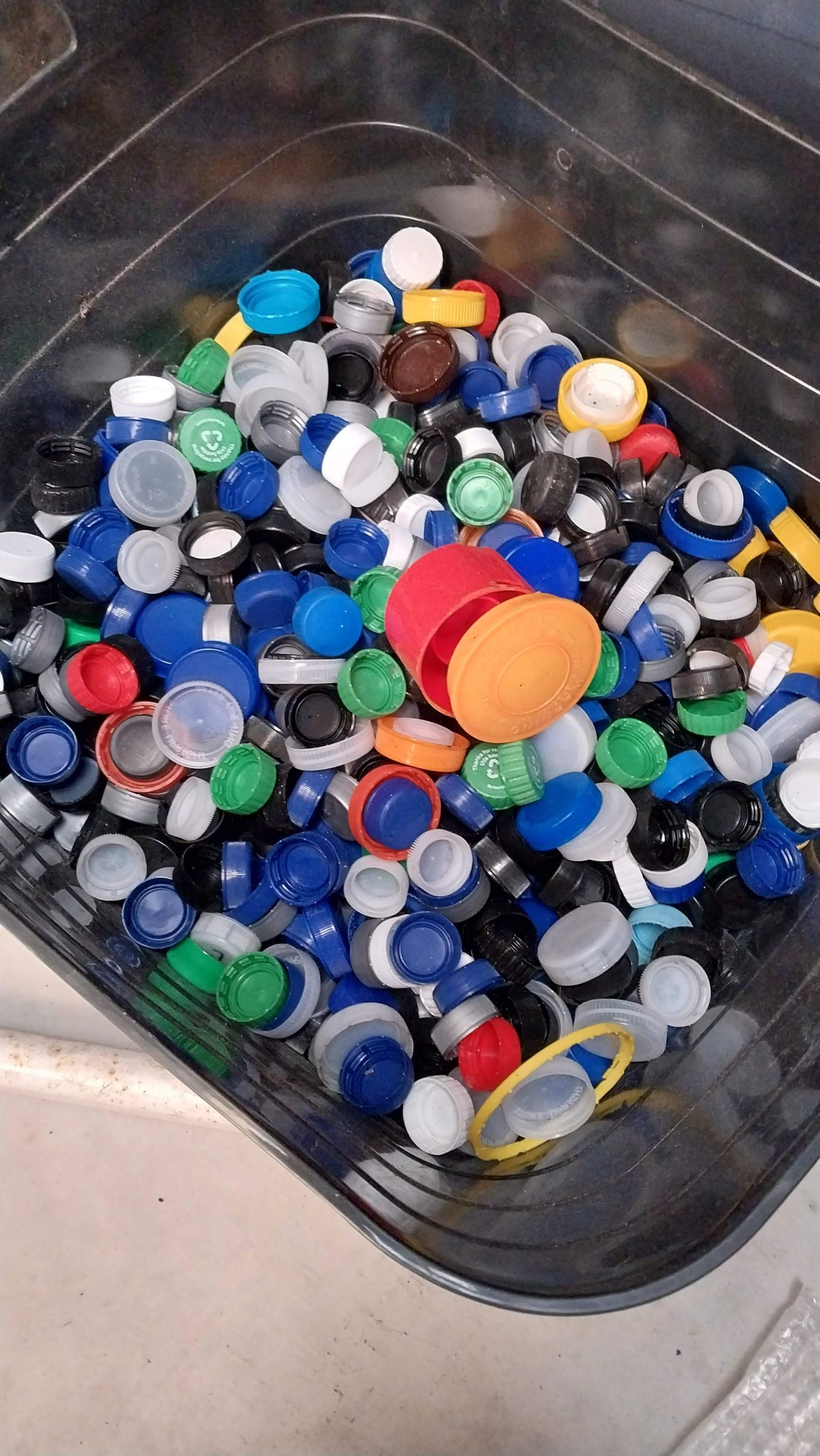This article is a bit of an issue for me. You see, people should be throwing ALL hard plastic into recycling, not getting confused by articles like this that seem to suggest that other people are throwing plastic bottle caps into the general waste. I’m not really sure where the author of that article gets the idea that unless the cap’s on the bottle it’ll get thrown into the landfill bin.
Does anyone actually do this? Plastics go into recycling and for most people that includes plastic bottle caps. So I think this article was just an effort to find something to comment about and appear to know something about recycling.
They say that “the rules around recycling can get confusing” but actually no. Listen to me – separate everything, but still put plastics into recycling. It’s no different than taking the paper drink cup, the plastic lid, and the paper straw, and putting them into the recycling separately.
What Would I Know?
The header image is a tub of plastic drink bottle caps I’ve collected. Some friends locally recycle their PET drink bottles, and I’ve convinced them to put the caps aside into a ziplock bag for me. A friend’s children make pocketmoney recycling their PET bottles and for every bag of caps they collect and bring me, I donate a few dollars to their pocketmoney fund. My friends are just doing it because it allows some local recycling to be done. (Well, one day when all my other tasks and chores are close to finished and I can afford to spend some quality time recycling…)
If you live close to me and want to send bottle caps, contact me. If there prove to be too many caps for me to process, I know another recycling facility quite near to places I have semi-regular appointments and can drop them off there. Now to get into a few more reasons to separate the bottle caps. Some caps have a seal insert in them. Milk jugs, for instance, quite often have that. If you leave it on the bottle, there’s no-one at the recycling facility whose job it is to unscrew every lid, so the lid and the insert get shredded and at that point it becomes hard to separate out the HDPE, PP, PET, and garbage contaminants. Because that’s what the insert is, it’s a contaminant and it reduces the value (and strength and purity) of the recovered HDPE or PP.
Some soy milk bottle caps go one further and make the insert a molded-on piece. Again, the molded-on piece is not PP like the rest of the cap, so it contaminates the batch of recovered plastic. A sorting machine with quite rudimentary AI can spot either kind of insert in a cap and reject them out of the process. But only if the caps are separated from the bottle in the recycle bin.
More Recycling Tips
I had a conversation on recycling a few weeks back – you do NOT have to wash out plastics, the recycler will by default wash the plastics while processing. Same goes for cans – the only reason to rinse any of these is to stop them from smelling bad in your kerbside bin or kitchen. It’s NOT hard to recycle, plastics glass and cans are all recyclable, paper and textiles are recyclable, even food scraps are recyclable.
Your local government will have information on what goes in what bins. For instance, plastics and tin cans (or aluminium cans too) are generally good to go in the same bin. Paper and textiles may have a separate bin, and most local governments these days take food scraps and garden waste to shred and turn into compost. But in a “green-waste” bin.
Batteries and e-waste are two separate waste streams. Paint, unused detergents, solvents, weedkillers, and so forth also need separate disposal. Don’t dispose of those liquids down the drain – they’ll get into groundwater and come back to haunt you and your grandkids. Most local governments have or know of a hazardous chemicals place and will tell you where to find it. For instance, in Australia any place with a “Hazchem” sign accepts them.
Enquire with your local government, they have lists of where to take hazardous chemicals as mentioned above, also batteries, mobile phones, other e-waste, and even larger metal items and white goods. The fewer of these things go to the local rubbish tip landfill, the cleaner the environment.
That Tubful Of Lids
If you want to try your hand at making something useful out of “waste” plastic then there are only a few that are easy enough to tackle with simple appliances.
BIG WARNING: Don’t use anything to process plastic and then use it to process foodstuffs again – use an old sandwich press or whatever and then keep it only for that. Don’t give it to goodwill or an opp shop, and if you’re ready to throw it out cut the cord off it and recycle it as described earlier. Yes HDPE, PP, PET, and LDPE are food-safe plastics but you can never really be sure hot hot you got them and how many volatile compounds have seeped into the appliance.

You can see in this picture, the HDPE cap with the insert that (preferably) has to be removed before processing. There’s also a PP milk jug cap and the lid of a spray can and an old “emergency gas cap” that’s never been used.
Other useful (and found in the home) sources of these value plastics are the lids and rings from Vegemite and peanut paste jars, the entirety of the large tomato sauce (ketchup) jugs, all of which are usually HDPE. The clear plastic jars of the peanut paste are usually PET so we send them to recycling.
Also – most all of those plastic nursery pots that plants come to you in, are PP.
This is handy because HDPE and PP can both be melted at fairly low temperatures, and both are good candidates for making outdoors items.
HDPE may soften in the sun on a hot day, but you can generally make items out of PP and they survive quite well in the sun.
A Few Tips And Pointers
Mixing plastics WILL result in weaker plastic products. The different plastics aren’t interchangeable. Also, plastics need to be washed clean of all the soft drink and food because those things will burn at the temperatures these plastics melt at, and leave pockets of carbon which will weaken the end product.
Another thing is uniformity. One reason home recyclers choose HDPE bottle caps is that they’re a uniform size and so they’ll all melt at the same time, meaning no small pockets of plastic that may melt first and burn.
This is one reason that plastic processing facilities shred all the plastic to a uniform size, it’ll all separate out by floating in different tanks, or dissolve in particular solvents. Since most home recyclers don’t have access to a plastic shredder, using bottle caps is the best we can get, unless we want to sit with scissors or shears and cut our material into similar size shreds.
Good news – if you decide to recycle nursery plant pots and can get your hands on a shredder that does paper, CDs, and credit cards, then you only have to cut the top and bottom from the pots and feed the sides through the shredder for pretty uniform results. The rims and bottoms are going to be more difficult to recycle so you may want to send them out.
I’m currently designing a reasonable plastics washer and once I do I’ll post the details here. The good news there is that if you have a small community you could make one and share it, because you really only need to wash the plastic once and then store in bags or bins.
BIG PROTIP: Plastic basically re-links when you melt it at the right temperature. Brothers Make (link in next section) tested HDPE and after the same plastic had been shredded and melted, one object made, the rest shredded and melted again, etc – after THIRTY recycles, they probably had enough left over to do another dozen cycles but the fact was that after being recycled thirty times, they couldn’t tell the difference between the first model and the thirtieth.
BUT BE CAREFUL: Heating plastic beyond the optimum temperature will release a lot of Volatile Organic Compounds (VOCs) and those are harmful to health – yours, your children and pets, your neighbours. Don’t use too high a temperature, always only just enough. A sandwich maker seems safe for both HDPE and PP from my tests. But I still used an extractor fan with a charcoal filter to grab any small VOC emissions, and wore a respirator mask, just in case.
How Profitable Can This Be?
Don’t plan to make a living from it if you’re doing small batch cottage industry sized things like I demonstrate. Also don’t be too fooled by Youtubers that demonstrate plastic recycling, that make their primary income from Youtube – the products are generally a side hustle not the primary source of income. That said, people like Precious Plastic do help small scale entrepreneurs set up viable businesses, and Brothers Make are a great place for instructional videos that show how to make a small sideline.
So hopefully this gives you a bit more interest and information than the article I featured. I’ve maintained that the job of waste recycling will start to become a much more prestigious employment because recycling plastics, cardboard, textiles, thin metals, e-waste, and food are all going to be seen as VERY important to the economy now. I’ve done some work on plastics, textiles, cardboard, and thin metals, and my food recycling is just to feed kitchen scraps to my worm towers, of which I have a past article but will create an updated and better documented article as time permits.
Link:
Please like and share this article among your social groups. There are links and buttons down below here that make it easy to do so. There are also links right down at the bottom of the page that will make it easy for you to donate to keep this site going.
Discover more from The TEdASPHERE Globe
Subscribe to get the latest posts to your email.
